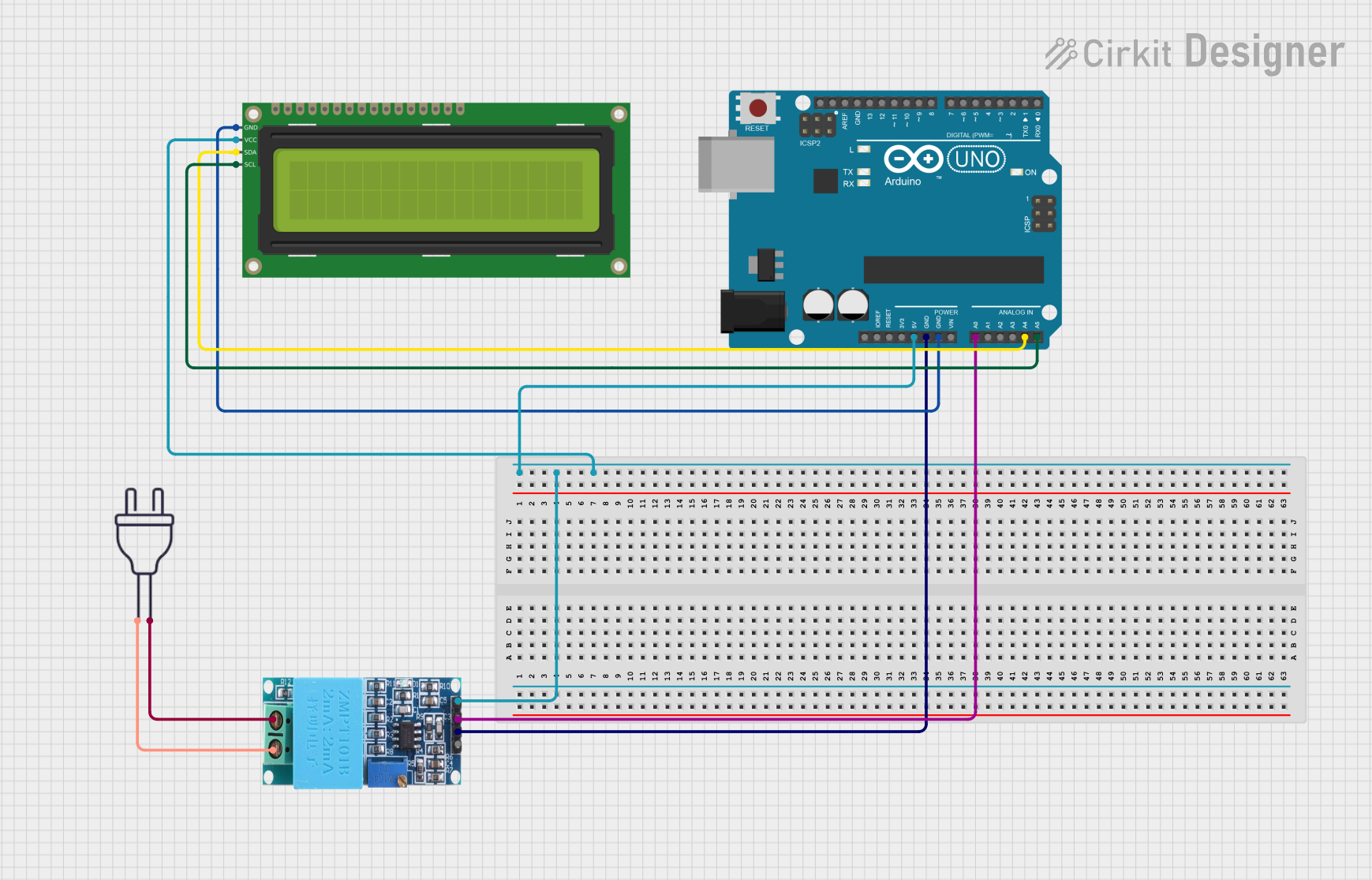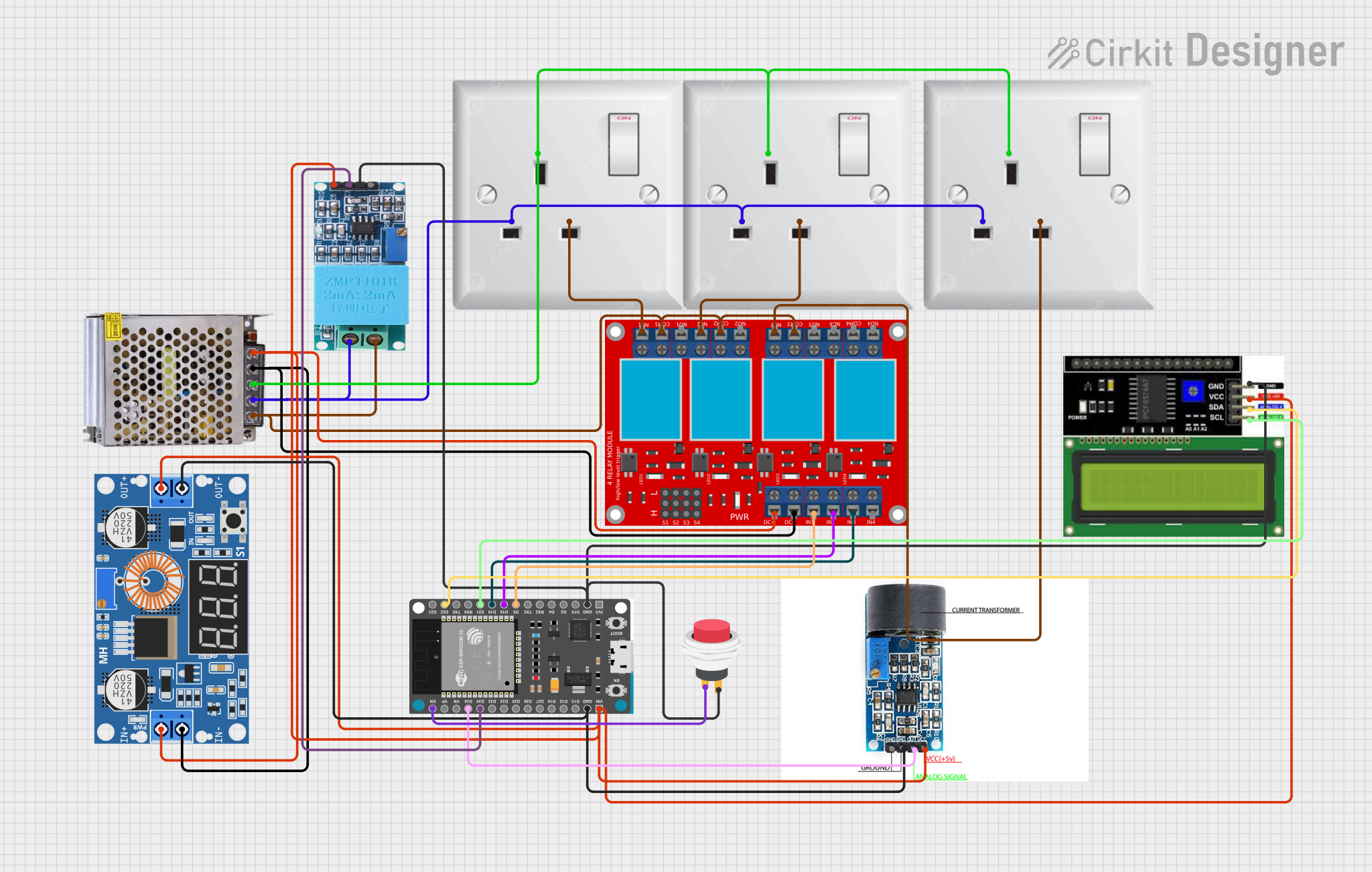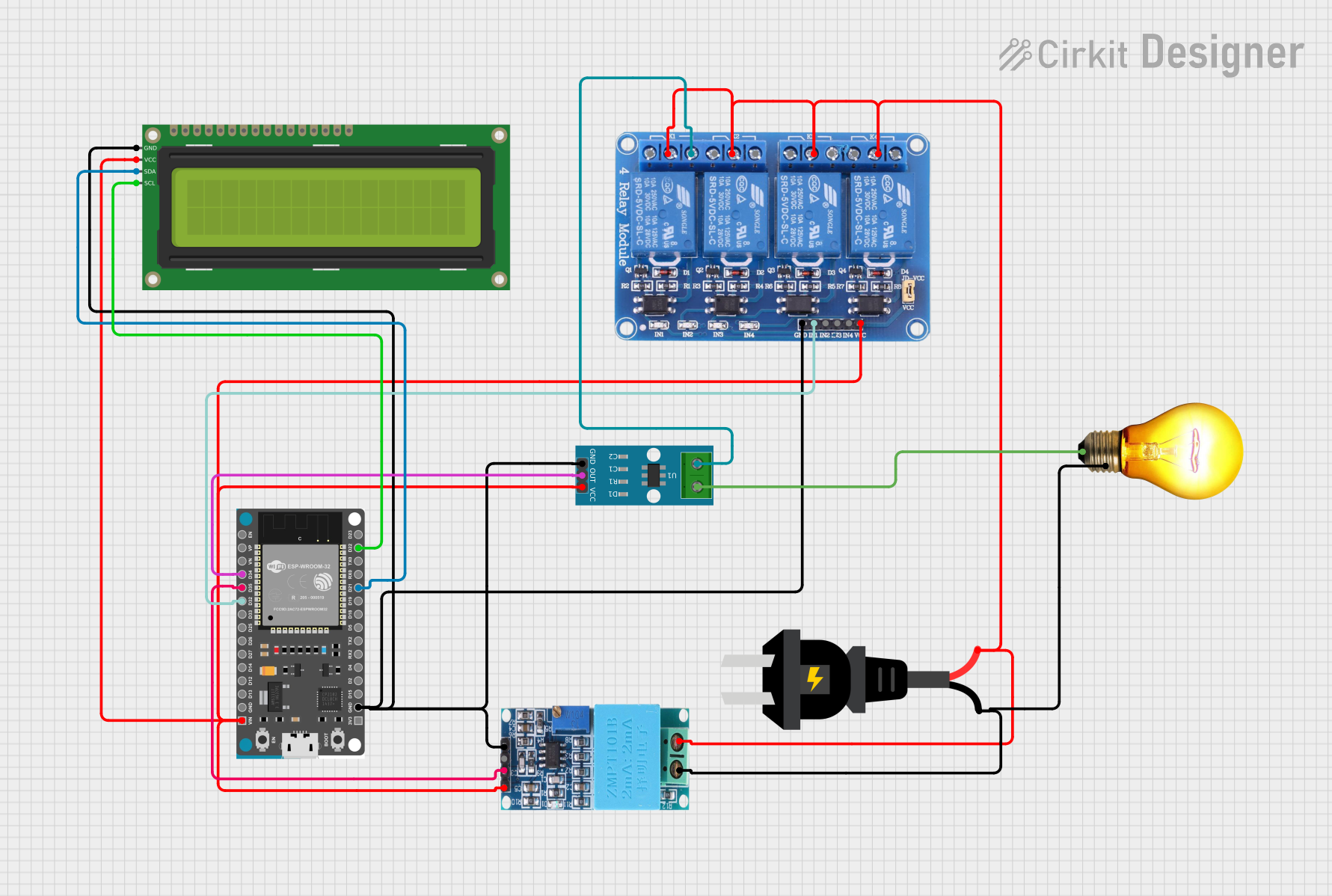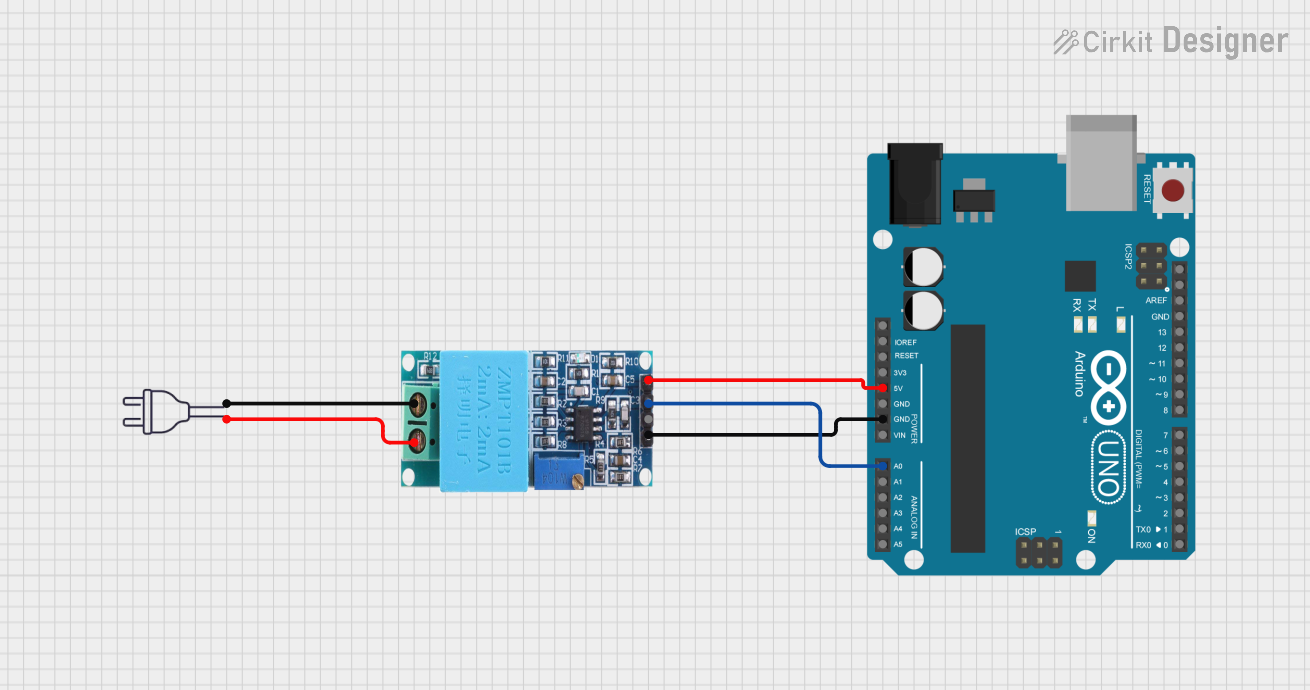
How to Use ZMPT101B AC Voltage Sensor: Examples, Pinouts, and Specs

 Design with ZMPT101B AC Voltage Sensor in Cirkit Designer
Design with ZMPT101B AC Voltage Sensor in Cirkit DesignerIntroduction
The ZMPT101B is a high-precision AC voltage sensor module designed for measuring AC voltage levels. It features a built-in ZMPT101B voltage transformer and operational amplifier circuit, ensuring accurate and isolated voltage measurements. This module is widely used in energy monitoring, power quality analysis, and control systems. Its compact design and ease of interfacing make it ideal for integration with microcontrollers, such as Arduino, Raspberry Pi, and other embedded systems.
Explore Projects Built with ZMPT101B AC Voltage Sensor

 Open Project in Cirkit Designer
Open Project in Cirkit Designer
 Open Project in Cirkit Designer
Open Project in Cirkit Designer
 Open Project in Cirkit Designer
Open Project in Cirkit Designer
 Open Project in Cirkit Designer
Open Project in Cirkit DesignerExplore Projects Built with ZMPT101B AC Voltage Sensor

 Open Project in Cirkit Designer
Open Project in Cirkit Designer
 Open Project in Cirkit Designer
Open Project in Cirkit Designer
 Open Project in Cirkit Designer
Open Project in Cirkit Designer
 Open Project in Cirkit Designer
Open Project in Cirkit DesignerCommon Applications
- Energy monitoring systems
- Power quality analysis
- Home automation and smart energy meters
- Industrial control systems
- Overvoltage and undervoltage protection circuits
Technical Specifications
Below are the key technical details of the ZMPT101B AC Voltage Sensor module:
| Parameter | Value |
|---|---|
| Input Voltage Range | 0–250V AC (adjustable via potentiometer) |
| Output Voltage Range | 0–5V DC (analog output) |
| Operating Voltage | 5V DC |
| Accuracy | High precision |
| Isolation | Electrical isolation via transformer |
| Dimensions | 49mm x 19mm x 16mm |
Pin Configuration and Descriptions
The ZMPT101B module has 4 pins, as described in the table below:
| Pin | Name | Description |
|---|---|---|
| 1 | VCC | Power supply input (5V DC) |
| 2 | GND | Ground connection |
| 3 | OUT | Analog output voltage proportional to AC input |
| 4 | ADJ | Potentiometer for sensitivity adjustment |
Usage Instructions
How to Use the ZMPT101B in a Circuit
- Power the Module: Connect the VCC pin to a 5V DC power supply and the GND pin to the ground of your circuit.
- Connect the Output: The OUT pin provides an analog voltage proportional to the AC input voltage. Connect this pin to an analog input pin of your microcontroller (e.g., Arduino).
- Adjust Sensitivity: Use the onboard potentiometer (ADJ) to calibrate the module for the desired input voltage range. This ensures accurate readings.
- AC Voltage Input: Connect the AC voltage source to the input terminals of the module. Ensure proper isolation and safety precautions when handling high-voltage AC.
Important Considerations and Best Practices
- Safety First: Always handle the module with care when working with high-voltage AC. Ensure proper insulation and avoid direct contact with live wires.
- Calibration: Adjust the potentiometer to match the expected voltage range for accurate measurements.
- Filtering Noise: If the output signal is noisy, consider adding a capacitor between the OUT pin and GND to filter high-frequency noise.
- Microcontroller Compatibility: The module outputs an analog signal, so ensure your microcontroller has an ADC (Analog-to-Digital Converter) to process the signal.
Example: Connecting ZMPT101B to Arduino UNO
Below is an example of how to interface the ZMPT101B with an Arduino UNO to measure AC voltage:
// ZMPT101B AC Voltage Sensor Example with Arduino UNO
// Reads the analog output from the ZMPT101B and calculates the AC voltage
const int sensorPin = A0; // ZMPT101B OUT pin connected to Arduino A0
float calibrationFactor = 100.0; // Adjust based on your calibration
void setup() {
Serial.begin(9600); // Initialize serial communication
}
void loop() {
int sensorValue = analogRead(sensorPin); // Read analog value from sensor
float voltage = (sensorValue / 1023.0) * 5.0; // Convert to voltage (0-5V)
// Calculate AC voltage using calibration factor
float acVoltage = voltage * calibrationFactor;
// Print the AC voltage to the Serial Monitor
Serial.print("AC Voltage: ");
Serial.print(acVoltage);
Serial.println(" V");
delay(1000); // Wait for 1 second before the next reading
}
Notes on Calibration
- The
calibrationFactorin the code must be adjusted based on the actual input voltage and the module's output. To calibrate, measure the actual AC voltage with a multimeter and adjust the factor until the readings match.
Troubleshooting and FAQs
Common Issues and Solutions
No Output Signal
- Cause: Incorrect wiring or no power supply.
- Solution: Verify all connections and ensure the module is powered with 5V DC.
Inaccurate Voltage Readings
- Cause: Improper calibration or noisy signal.
- Solution: Adjust the potentiometer and ensure proper grounding. Add a capacitor to filter noise if necessary.
Microcontroller Not Detecting Signal
- Cause: Incorrect analog pin configuration or damaged module.
- Solution: Check the analog pin setup in your code and test the module with a multimeter.
FAQs
Q: Can the ZMPT101B measure DC voltage?
A: No, the ZMPT101B is designed specifically for AC voltage measurement.
Q: What is the maximum AC voltage the module can measure?
A: The module can measure up to 250V AC, but this depends on the calibration and input configuration.
Q: How do I ensure safety when using this module?
A: Always use proper insulation, avoid direct contact with live wires, and follow standard electrical safety practices.
Q: Can I use this module with a Raspberry Pi?
A: Yes, but since the Raspberry Pi lacks an onboard ADC, you will need an external ADC module to process the analog output from the ZMPT101B.
By following this documentation, you can effectively integrate the ZMPT101B AC Voltage Sensor into your projects for accurate and reliable AC voltage measurements.